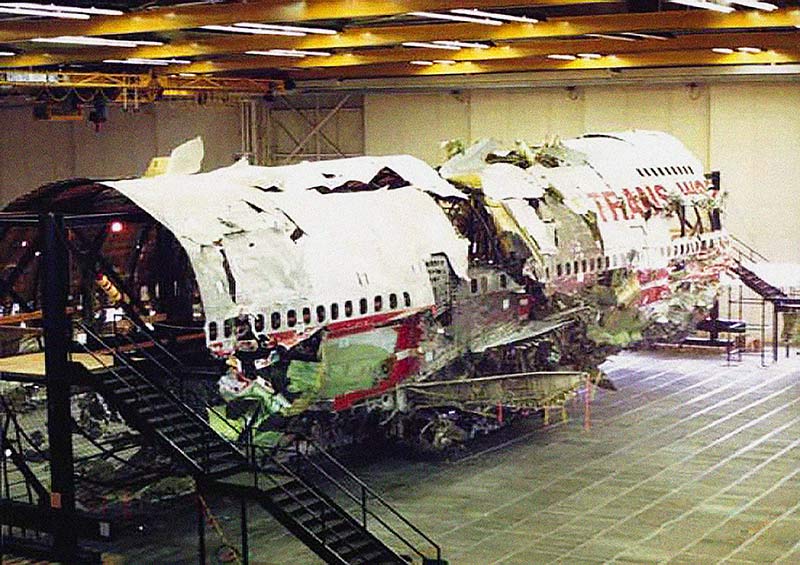NTSB’S Reconstruction of the TWA Flight 800 Fuselage to be Decommissioned
The Landing

The shattered fuselage of TWA Flight 800, a B-747-131, was reconstructed at the NTSB Training Center in Ashburn, Va. ALPA played a key role in the NTSB’s investigation into the probable causes of the accident.
Earlier this year, the NTSB announced that in July it would decommission the reconstruction of the TWA Flight 800 wreckage—nearly 25 years after the accident—due to advances in investigative techniques, such as 3-D scanning and drone imagery. The reconstruction, housed in the 30,000-square-foot hangar at the NTSB’s Training Center in Virginia, has been used in the NTSB’s accident investigation training courses since 2001. Hundreds of ALPA members have taken part in those courses.
“It’s been an amazing resource for ALPA representatives who’ve attended the Accident Investigation Course to see, explore, and appreciate,” said F/O Steve Demko (United), ALPA’s Accident Investigation Board chair. “It was a tremendous opportunity for our students to visit the NTSB Training Center to get a sense of an investigation’s sheer size and the advanced techniques used in reconstruction of wreckage. The NTSB investigators did an outstanding job explaining how they reassembled the wreckage, providing essential details and insights needed to support and determine facts and circumstances of the tragedy. We greatly appreciated their time and efforts in sharing such a unique resource with ALPA members,” Demko added.
On July 17, 1996, shortly after 8:30 p.m. EST, TWA Flight 800, a B-747-131, was destroyed by an explosion of the fuel/air mixture in the center wing fuel tank. The aircraft was climbing through 13,700 feet, experienced an in-flight breakup, and impacted the Atlantic Ocean some 15 miles off the south shore of Long Island, N.Y., killing all 230 passengers and crewmembers aboard. The wreckage was originally reconstructed in Calverton, N.Y., and then subsequently moved to the NTSB Training Center in Ashburn, Va.
The investigation, which took more than four years, concluded that the accident’s probable cause was an “explosion of the center wing fuel tank, resulting from ignition of the flammable fuel/air mixture in the tank. The source of ignition energy for the explosion couldn’t be determined with certainty, but of the sources evaluated by the investigation, the most likely was a short circuit outside of the center wing fuel tank that allowed excessive voltage to enter it through electrical wiring associated with the fuel quantity indication system.”
“The investigation of the crash of TWA Flight 800 is a seminal moment in aviation safety history,” said NTSB Managing Director Sharon Bryson in a press release. “From that investigation, we issued safety recommendations that fundamentally changed the way aircraft are designed.”
ALPA pilots and staff aided the investigation and supported the board’s conclusions, noting in comments submitted to the NTSB that “The investigation has significantly advanced industry knowledge and understanding of many aspects of the ‘basic sciences’ related to this accident. These areas included aircraft systems design, certification and inspection practices, aircraft systems and component degradation, fuel flammability, and explosion dynamics.”
“TWA 800 is a great example of the importance of letting the investigation ‘run its course’ to get to the causes of an accident,” Demko added. “It was a very long, complex, and expensive investigation that was able to make the correct conclusion since investigators took the time to ensure that they had all the factual information to analyze.”
After the digital documentation of the wreckage is complete, the NTSB will dismantle and destroy the reconstruction.

